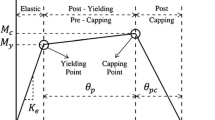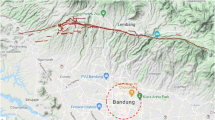Abstract
This study was carried out to evaluate the functionality of an existing reinforced concrete structure under various ground motions along with its seismic resilience. An existing high-rise G + 10 storey reinforced concrete building which was designed for a specific ground motion with peak ground acceleration (PGA) of 0.36 g was subjected to various seismicity with respect to different ground motions of PGA ranges from 0.10 to 1.70 g. For each case, the performance level and structural damage ratio were estimated by performing nonlinear static pushover analysis. The influences of different ground motions on the structural functionality and seismic resilience were examined using three recovery functions namely, linear, trigonometric and exponential. The result shows that the maximum number of hinges formed with the performance level close to or just exceeding the level of collapse prevention at the maximum considered PGA of 1.50 g and 1.70 g with loss of resilience up to 36.25%. The maximum level of PGA that the existing building would withstand along with likelihood of recovery has been obtained.

















Similar content being viewed by others

References
Hudson S, Cormie D, Tufton E, Inglis S (2012) Engineering resilient infrastructure. Proc Inst Civ Eng Civ Eng 165(6):5–12
Gallagher D, Cruickshank H (2015) Planning under new extremes: resilience and the most vulnerable. Proc Inst Civ Eng Munic Eng 169(3):127–137
Grigorian M, Kamizi M (2021) High-performance resilient earthquake-resisting moment frames. Proc Inst Civil Eng Struct Build 175(5):401–417
Belejo A, Barbosa AR, Bento R (2013) Influence of ground motion duration on damage index-based fragility assessment of a plan-asymmetric non-ductile reinforced concrete building. Eng Struct 151:682–703
Kamaludin PNC, Kassem MM, Farsangi EN, Nazri FM, Yamaguchi E (2020) Seismic resilience evaluation of RC-MRFs equipped with passive damping devices. Earthq Struct 18(3):391–405
Marasco S, Cardoni A, Noori AZ, Kammouh O, Domaneschi M, Cimellaro GP (2021) Integrated platform to assess seismic resilience at the community level. Sustain Cities Soc 64:102506
Dukes J, Mangalathu S, Padgett JE, DesRoches R (2018) Development of a bridge-specific fragility methodology to improve the seismic resilience of bridges. Earthq Struct 15(3):253–261
Hashemi JM, Al-Attraqchi AY, Kalfat R, Al-Mahaidi R (2019) Linking seismic resilience into sustainability assessment of limited-ductility R.C. buildings. Eng Struct 188:121–136
Cimellaro GP, Reinhorn AM, Bruneau M (2010) Framework for analytical quantification of disaster resilience. Eng Struct 32:3639–3649
Cimellaro GP, Reinhorn AM, Bruneau M (2010) Seismic resilience of a hospital system. Struct Infrastruct Eng 6(1–2):127–144
Hadigheh AS, Mahini SS, Setunge S, Mahin SA (2016) A preliminary case study of resilience and performance of rehabilitated buildings subjected to earthquakes. Earthq Struct 11(6):967–982
Venkittaraman A, Banerjee S (2013) Enhancing resilience of highway bridge through seismic retrofit. Earthq Eng Struct Dyn 43:1173–1191
Deco A, Bocchini P, Frangopol DM (2013) A probabilistic approach for the prediction of seismic resilience of bridges. Earthq Eng Struct Dyn 42:1469–1487
Mahini SS, Hadigheh AS, Setunge S (2015) Seismic resilience of retrofitted reinforced concrete buildings. In: Proceedings of the second international conference on performance-based and life-cycle Structural Engineering, Australia
Bocchini P, Frangopol DM (2012) Optimal resilience and cost-based post disaster intervention prioritization for bridges along a highway segment. J Bridg Eng 17(1):117–129
Gehl P, D’Ayala D (2018) System loss assessment of bridge networks accounting for multi-hazard interactions. Struct Infrastruct Eng 14(10):1355–1371
Zou XK, Teng JG, Lorenzis DL, Xia SH (2007) Optimal performance-based design of FRP jackets for seismic retrofit of reinforced concrete frames. Compos B Eng 38:584–597
Burton H. V, Deierlein G, Lallemant D, Lin T (2016) Framework for incorporating probabilistic building performance in the assessment of community seismic resilience. J Struct Eng 142(8): C4015007 (1–11)
Burton HV, Deierlein G, Lallemant D, Singh Y (2017) Measuring the impact of enhanced building performance on the seismic resilience of a residential community. Earthq Spectra 33(4):1347–1367
Shinozuka M, Chang SE, Cheng TC, Feng MQ, O’Rourke TD, Ala M, Dong X, Jin X, Wang Y, Shi P (2004) Resilience of integrated power and water systems. Multidiscip Center Earthq Eng Res 155:22–43
Cai H, Lam NSN, Qiang Y, Zou L, Correll RM, Mihunov V (2018) A synthesis disaster resilience measurement methods and indices. Int J Disaster Risk Reduct 31:844–855
Bruneau M, Chang SE, Eguchi RT, Lee GC, Reinhorn AM, Shinozuka M, Tierney K, Wallace WA, Winterfeldt VD (2019) A framework to quantitatively assess and enhance the seismic resilience of communities. Earthq Spectra 19(4):733–752
Hakim RA, Alama MS, Ashour SA (2014) Seismic assessment of RC building according to ATC-40, FEMA-356 and FEMA-440. Arab J Sci Eng 39:7691–7699
IS: 1893 (2016) Part-1. Indian standard criteria for earthquake resistance design of structures. Bureau of Indian Standards, New Delhi
SAP2000. Integrated software for structural analysis and design. Computers and Structures Inc, Berkley
ATC-40 (1996) Seismic evaluation and retrofit of reinforced concrete buildings. Applied Technology Council
Leslie R (2012) The pushover analysis in its simplicity. Seism Saf 25:118–126
FEMA-440 (2005) Improvement of nonlinear static seismic analysis procedures. Federal Emergency Management Agency
ASCE/SEI 41-17 (2017) Seismic evaluation and retrofit of existing buildings. American Society of Civil Engineers
FEMA-356 Prestandard (2000) Prestandard and commentary for seismic rehabilitation of buildings; Washington DC
HAZUS MR4 Technical Manual (2003) Multihazard Loss Estimation Methodology. Department of Homeland Society, Washington DC
FEMA-276 (1999) Example applications of the NEHRP guidelines for the seismic rehabilitation of buildings, Federal Emergency Management Agency and US army corps of engineers. Washington DC
Barbat AH, Pujades LG, Lantada N (2008) Seismic damage evaluation in urban areas using the capacity spectrum method: application to Barcelona. Soil Dyn Earthq Eng 28:851–865
Author information
Authors and Affiliations
Corresponding author
Ethics declarations
Conflict of interest
The authors declare that they have no conflict of interest.
Additional information
Publisher's Note
Springer Nature remains neutral with regard to jurisdictional claims in published maps and institutional affiliations.
Rights and permissions
Springer Nature or its licensor (e.g. a society or other partner) holds exclusive rights to this article under a publishing agreement with the author(s) or other rightsholder(s); author self-archiving of the accepted manuscript version of this article is solely governed by the terms of such publishing agreement and applicable law.
About this article
Cite this article
Prasanth, S., Ghosh, G. Effect of Seismicity on the Seismic Resilience of a R.C. Building. Proc. Natl. Acad. Sci., India, Sect. A Phys. Sci. 93, 147–161 (2023). https://doi.org/10.1007/s40010-022-00803-x
Received:
Revised:
Accepted:
Published:
Issue Date:
DOI: https://doi.org/10.1007/s40010-022-00803-x



